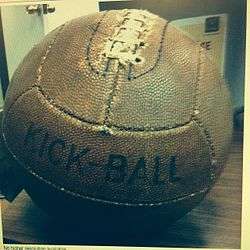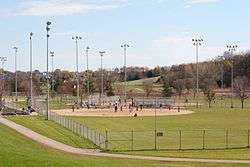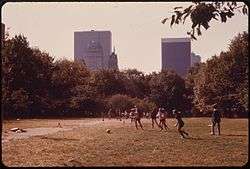Kickball
Kickball (also known as soccer baseball in most of Canada) is a game and league game, similar to baseball, invented in the United States by Nicholas C. Seuss. As in baseball, one team tries to score by having its players return a ball from home base to the field and then circle the bases, while the other team tries to stop them by tagging them "out" with the ball before they can return to the home base. Instead of hitting a small, hard ball with a bat, players kick an inflated rubber ball; this makes it more accessible to young children. As in baseball, teams alternate half-innings. The team with the most runs after a predefined number of innings wins.
.jpg)
Kickball is a popular playground game and is typically played among young, school-age children. The lack of both specialized equipment and highly skill-based positions (like pitcher) makes the game an accessible introduction to other sports. It is just as popular among adults, who are more commonly known to play similar games like softball and baseball.
History
Kickball, originally called "Kick Baseball" or "kick cabbage" , was invented as early as 1917 by Nicholas C Seuss, Supervisor of Cincinnati Park Playgrounds in Cincinnati, Ohio.[1] Seuss submitted his first documented overview of the game which included 12 rules and a field diagram in The Playground Book, published in 1917. Kickball is referred to as "Kick Base Ball" and "Kick Baseball" in this book.[2]

Around 1920–1921 "Kick Ball" was used by physical education teachers in public schools to teach young boys and girls the basics of baseball. Around this time, the ball that was used was a soccer ball or volleyball. It was played by ten to thirty players and the field included a "Neutral Zone": an area not to be entered until the ball has actually been kicked. There was no pitcher as the ball would be kicked from the home area, which was a 3 ft circle. The ball must pass beyond the 5 foot line. Base-runners could only advance one base on infield balls. Teams would switch sides only after all team members have kicked.[3]


During this time, it was played on the same field as baseball except that there was only one base corresponding to a baseball diamond's 2nd base. Multiple players could be on base at a time, but all needed to get home before the last kicker kicked and the kicking order had retired.[4]
There were also two short stop player positions: one between 1st and 2nd and the other between 2nd and 3rd. Home plate was marked by a 3 ft by 4 ft rectangle on the ground.[5]
Published in April 1922, Daniel Chase; Supervisor of Physical Education for the New York State Department of Education, describes the earliest known account of adults playing kickball. This game took place at a conference of rural teachers in Mooers Forks, Clinton County, NY where Daniel was teaching games that the teachers could in turn teach to their pupils. They did not have a ball, so they made one out of an old stocking and some rags. The ball was about 7 to 8 inches long and tied off with an old shoelace. The construction of this makeshift ball was demonstrated to the rural teachers by Mr. Braddock Wells. The teachers were assigned numbers to create teams; odd numbers on one team and even numbers on the other. The team captains chose college names to represent each team name. The odds chose Yale & the evens chose Princeton. The game of "Kick Baseball" was the last game they played at the conference to decide the championship for the day. 10 players were chosen for each team and the remaining were organized into a cheering section. Yale kicked first. On the field there was no pitcher, but an extra short-stop between first and second. Only three innings were completed in the heat that day, with Yale ending up as the victor winning 3 to 2. The cheering sections showed great sportsmanship, applauding all good plays impartially.[6]
American World War II correspondent Ernie Pyle reported it being played by U.S. soldiers during the Tunisia Campaign, 1942–43.[7]
"Kick Ball" was promoted as an informal game for soldiers by the United States Department of the Army as early as 1943. In this variant of the game, all kicks had to be home runs, by beating the kicked ball back to home after consecutive passes to all basemen before throwing them out at home.[8]
Field
The game is typically played on a softball diamond with an 8.5 inch to 16 inch diameter inflated rubber ball. As in baseball/softball, the game uses 3 bases, a pitcher's mound, and a home plate. Sometimes, in less formal games, the field is not bounded by a fence as in softball or baseball, but is open. This may result in informal rule changes to accommodate the field. Also it can be played on a rectangular blacktop area with chalk or paint outlines.
Kicking strategy
The objective of kickball is to win by scoring more runs than the opposing team, thus kicking (or offensive) strategy is very important. Assuming the rules allow bunting, one popular strategy for putting runners in scoring position is to place fast kickers, particularly those with the ability to bunt the ball in specific directions, near the top of the line-up. Using this strategy, a team might put a fast player who can bunt down the third base line first in the line-up. That player would bunt down the third base line, forcing either the third baseman, the pitcher, or the catcher to field the ball and throw the runner out at first base. This is an optimal play with no outs and no players on base because throwing the ball from third to first base accurately is difficult. A well-placed bunt on the ground also removes the opportunity for the defense to catch the ball in the air for an easy out and can create fielding confusion between the third baseman, the pitcher and the catcher. The runner would then advance as far as their kick and the opposing team's defensive play allows him or her to advance. The next kicker would take stock of the base to which the first kicker has advanced and would try to kick the ball to a place that will maximize the first runner's ability to advance and the second kicker's ability to get on base safely. For instance, if the first kicker is on first base, the second kicker might also kick down the third base line. This would give both kickers a good chance of safely advancing to the next base.
Ideally, a team would have runners on base and fewer than two outs once three to four kickers have kicked following this bunting strategy. At that point in the line-up, it is advantageous to place one or two kickers who can kick the ball into the outfield. The time it takes to field a ball from the outfield will ideally allow runners on base to score, even if the ball is caught in the outfield.
Kickball in the United States
In the past, kickball was mostly considered a child's game in the United States, although recently many US cities have created kickball leagues only for adults. Some US cities have multiple organized leagues for adults over 21 years of age. It gained prominence in the 1970s.[9]
Kickball outside the United States
Kickball is popular among youth in South Korea. Known as balyagu [발야구 (foot-baseball)], it is a staple in PE classes within elementary schools. Kickball is referred to as Soccer-Baseball, Chinese Baseball or California Kickball in some parts of Canada. In Japan kickball is played by elementary school students and is known as キックベース(Kickbase).[10] In England, the variation is often played in P.E. lessons in schools and is referred to as 'Football-Rounders', a mix of association football and rounders.[11]
Kickball rules
The World Adult Kickball Association, the largest sanctioning body for the sport of recreational Kickball[12], maintains the official rules of the game. According to this rule set, Kickball games should be 7 innings long, with 10 players defending the field, and pitch counts where 4 balls results in a walk, 3 strikes results in an out, or 3 foul balls results in an out.
References
- The Playground. Playground and Recreation Association of America. 1969. p. 240. Retrieved 2010-04-19.
- The Playground Book. Cincinnati Board of Education (Ohio), Cincinnati (Ohio). Board of Park Commissioners. 1917. pp. 82–83. Retrieved 2014-09-17.
- Mind and Body – A Monthly Journal devoted to Phycical Education Vol 27. The Mind and Body Publish Company. 1921. pp. 205–206. Retrieved 2010-04-19.
- University of the State of New York Bulletin, Issue 724. fortnightly. 1920. pp. 131–132. Retrieved 2010-04-19.
- School, Church, and Home Games. Association Press. 1922. pp. 41. Retrieved 2010-04-19.
kick ball.
- The Instructor, Volume 31. F.A. Owen Publishing Company. 1922. p. 26. Retrieved 2013-09-19.
- Here Is Your War; Story of G.I. Joe. H. Holt, New York. 1943. p. 28. ISBN 9780803287778. Retrieved 2012-02-21.
- Informal games for soldiers. U.S. government printing office. 1943. p. 6. Retrieved 2013-09-18.
- Parker, Suzi (25 August 2013). "The Zombies and Non-Prophets of Little Rock". Al Jazeera. New York City. Retrieved 25 August 2013.
- "21 kick Baseball". Toyama Prefectural Board of Education. Retrieved 14 November 2013.
- "secondary Intra-school/Level 1 Resource" (PDF). Your School Games. Retrieved 15 February 2016.
- Parker, Ashley (2006-09-15). "Getting a Kick Out of Kickball". The New York Times. ISSN 0362-4331. Retrieved 2019-09-20.
External links
| Wikimedia Commons has media related to Kickball. |
- Parker, Ashley (2006-09-15). "Getting a Kick Out of Kickball". The New York Times. Archived from the original on 2006-11-26. Retrieved 2006-09-29.
- Skipp, Catharine; Dishongh, Kimberly (2006-08-21). "Trends: All for the Love of the Game". Newsweek. Retrieved 2007-03-19.
- Beja, Marc (2008-02-05). "Still Kicking". Washington Square News. Archived from the original on 2011-07-26. Retrieved 2008-10-16.
- Whirty, Ryan (2009-07-29). "Follow the red bouncing ball". CITY Newspaper. Retrieved 2012-01-02.